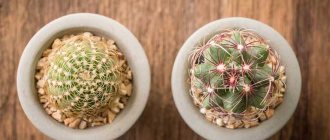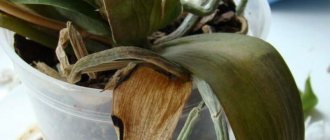The cactus is an original and beautiful plant that is grown by many. Due to its particular unpretentiousness, flower growers want not only to have such beauty at home, but also, if possible, to breed it. Therefore, it is especially important for such people to know how to plant a cactus correctly.
If we talk about breeding, the easiest way to do this is with the help of shoots. The reason for this is that after planting, the children take root quite quickly. Although, of course, first you should separate this very process. The procedure must be performed with extreme caution so that no “mother material” remains on the shoot, and no baby parts remain on the main cactus. Many, when seating children, do not pay due attention to this, but it is completely in vain, since the remaining parts can lead to rotting.
The procedure can be performed at any time, but “experienced gardeners” advise breeding in the spring and summer, because that is when roots grow best from the shoot.
It is worth remembering that after separation the baby cannot be immediately planted in the ground, because it will probably rot; you should wait until the cut dries well. Until this time, it is better to place the shoot in a dark and cool room. After this, you can plant the baby in a small container, pre-filled with a substrate with the addition of a large amount of sand.
It should be noted that the sand is added wet, and watering is not necessary. Planting material is laid out on the prepared soil, but not deepened. When the appearance of roots is noticed, then you can start fully planting the still very young cactus.
Having figured out how to plant a cactus that was obtained using shoots, you can move on to which substrate to give preference to and why.
Important! Sometimes you can notice aerial roots on the shoot, which are easily separated from the mother plant. Such planting material can be planted in the ground within a day.
What time of year is best to propagate?
Planting a cactus shoot can be done throughout the year , but still the best time is spring and summer.
The fact is that the birthplace of succulents are countries with hot climates. The temperature regime and daylight hours during spring and summer are close to the “native” weather conditions of this flower. In addition, any plant in warm weather experiences a phase of active vegetative development, which will greatly facilitate the process of rooting the succulent. In late autumn and winter, you can also try to plant a baby adult cactus, but you must remember that the young plant will need additional care: providing enough light, observing the temperature regime.
Selection and preparation of land for planting
Priming
Ordinary garden soil is not suitable for rooting and growing cactus. A special substrate for succulents can be purchased at a flower shop, the main components of which will be river sand, humus from leaves and turf, peat and all the necessary nutrients.
If it is not possible to purchase this mixture, you can prepare it yourself:
- coarse river sand, garden soil, peat mixed in a ratio of 1:1:0.5;
- you can add some crushed dry leaves and foam balls.
Drainage
A necessary component of the internal filling of the pot, in which a cactus without roots will be planted, is drainage - a layer of certain materials that helps drain excess water when watering. The drainage volume should occupy a maximum of 1/5 and a minimum of ½ of the container. Drainage may consist of :
- expanded clay;
- pebbles;
- small pebbles;
- broken bricks;
- broken foam;
- pre-cut wine corks.
Selecting and preparing a pot
Material
Many gardeners advise planting succulents in plastic containers , since plastic is a substance that does not absorb water and does not change the temperature of the soil placed in the pot.
Lovers of everything environmentally friendly can easily plant a succulent in a container made of clay or ceramics.
It is better if the pot is light in color so that the soil in it heats up less.
Size
Cacti grow in arid climates, so they have a long root system . Therefore, when choosing dishes, it is necessary to take into account the fact that its root system needs space, which means that cramped and small dishes will not be suitable for planting. Preference should be given to wide and deep dishes, in which the roots of the plant will feel free and will receive a sufficient amount of moisture and nutrients.
The main condition that a cactus pot must meet is the presence of drainage holes to drain excess water. Otherwise, the liquid accumulating at the bottom will cause the roots of the succulent to rot and, consequently, lead to its death.
Watering
It is very important for a novice gardener to know how to plant cactus children, because the health of the plant will depend on the correct transplantation. Another very important component of the good growth of prickly flowers on the windowsill is their proper watering. In order for the flowers to grow well, you need to ensure that the soil is not wet all the time, it should be slightly dry. Watering should be moderate; if you pour a lot of water, then the root system will rot, which will lead to the death of the plant. In the winter period of the year, the plant stops growing, they seem to hibernate, at this time they need to be watered once a month, this will be enough so that they do not die. It is very easy to determine when a flower needs watering; look at the ground; if it is dry and begins to crack, it means you need to water it lightly. Now you know how to plant cacti and care for them.
To better understand how cacti reproduce, we have prepared a useful video for you:
Source
How to properly take a shoot with roots, what to pay attention to?
Before planting a shoot, you need to select and prepare it. “Children” are formed on the cactus itself in the process of its life . They can be located either on the top of the plant or at the bottom, at the very roots, it all depends on the type of succulent. Separating them from the mother plant is not difficult, because they are minimally connected to the stem. While still on an adult cactus, the shoots of most types of succulents begin to produce roots. In addition, over time, the shoots can fall off and, falling to the ground, begin to develop their root system, so reproduction occurs without problems.
When choosing a shoot for transplantation, it is important to pay attention to its size (a large one is stronger and more viable), its location (it is believed that high-quality shoots grow closer to the top of the plant).
also propagate cactus with “babies” that do not have roots - this will not cause any particular difficulties. In any case, the shoot is placed on a clean, dry sheet of paper and placed for 3 days or 1 week in a dark and cool place to slightly dry the cut site (this is done to prevent rotting of the shoot). Read more about all the ways to plant a cactus without roots in this article.
Suitable place for the plant
When studying information about your purchase, pay attention to the environment in which it grows in nature. In our minds, all cacti grow in the desert, so at home we try to create similar conditions. Such a climate will be unacceptable for those varieties that grow in the forest and are accustomed to shade and humidity. Therefore, a window sill is suitable for some, and a chest of drawers or a shelf for others.
The main thing is that they are in the light and not in the shade.
Conditions for all cacti should be slightly different during the summer and winter periods. In the first case, moderate but constant air humidification, timely watering and sufficient lighting are necessary. In the second, the air temperature should be significantly lower, as well as soil moisture. The main thing in both cases is to beware of overheating and sunburn. If the cactus is on the windowsill, it needs protection equally from heating devices and from aggressive sunlight.
In summer, cacti can be safely placed on a glassed-in balcony. In this case, they do not need to be brought indoors at night, since in the same desert it is quite cool at night. Ventilation is important for them so that the air does not stagnate. But this process must be organized without drafts . It is better to gradually accustom them to bright light and different air temperatures.
Cacti do not like rearrangements - you can put marks on the pots so that you do not inadvertently place them with the other side facing the light.
Most often, the placement of cacti is associated with various rumors and signs. For example, according to Feng Shui, the south-eastern part of the room is best suited for them. It is believed that placing it on a windowsill repels negative energy from the street and protects against thieves. And placement near electrical appliances reduces the influence of negative radiation. There is no scientific evidence for these superstitions.
Therefore, when placing a pot with a plant, first of all you need to think about its comfort - in poor conditions, development will be slow, and frequent movements can affect the change in appearance.
Photo
In the photo you can see a cactus with “babies”:
Step-by-step instructions: how to plant a flower and a shoot with or without roots?
Let's take a closer look at how to transplant shoots without roots or with roots from an adult plant .
- Separate the shoots from the mother plant with a sharp knife or tweezers.
Despite the fact that the “babies” are not firmly attached to the mother plant, the shoots must still be separated very carefully: if the slightest particle of the “babies” remains on the cactus, the plant may rot and the sprout will not take root. - Prepare everything you need for planting: pot, soil, drainage, withered shoots, spatula.
- Place a drainage layer on the bottom of the pot.
- Cover the rest of the container with soil, which must be moistened.
- You need to make a small depression in the center of the pot.
- Place the “baby” cactus in the recess, cut side down, without digging in. If the “baby” has roots, then after placing them in the recess they must be carefully straightened.
- You need to lightly press the ground with your hands in order to fix the shoot in one position. You can’t bury it too deep!
To prevent intense evaporation of moisture from the soil surface, small pebbles or sea pebbles can be placed on top .
Rooting cuttings
Cuttings are rooted following certain rules.
It is necessary to prevent excessive drying and protect both parts of the plant from infection. After cutting, both cuts should be sprinkled with sulfur powder or crushed charcoal. Wounds will heal faster in a warm and dry place; excessive drying out can be avoided by covering the plant with something, such as paper. Cuttings root faster and better if they are dried longer: thin ones - at least a week, and thick ones - at least two weeks.
Cuttings should be sharpened at the cut and dried in a vertical position. Since when drying, the internal, fleshy parts of the plant are pulled deep inside under the hard skin, the edges of the cutting plane, especially in thicker specimens, need to be trimmed. All cuttings, except prickly pears, are lightly sharpened, like a pencil, from the cut end. If this is not done, then although unsharpened cuttings take root faster, the roots from them are incomplete and short-lived. The answer here is simple: upon contact with wet sand, roots grow very quickly from under the areoles close to the cut, most often on one side of the stem. After this, the roots from the cambial ring no longer appear, and the cactus turns out to be rooted one-sidedly. Such one-sided roots, even though they have grown and branched, do not hold the stem well; it easily warps and even falls. Everything has to start all over again. A sharpened cutting, in which the lower areoles are cut off, produces normal roots from the central part of the stem.
Cuttings should only be dried in a vertical position. If you simply lay them out on a horizontal plane (this is easier at first glance), the side on which the cutting lies will turn out to be dotted with numerous root tips that have broken right through the skin, between the ribs of the cactus. The cutting is irreparably damaged: even after cutting off these “illegal” roots and subsequent proper rooting, scars will remain on the stem. Substances that promote the formation and growth of roots and come to them from the above-ground part of the plant are deposited not at the lower cut of the cutting, where new roots should appear, but along the edge on which it lies.
For vertical drying, cuttings can be placed, like a bouquet in a vase, in some porous tall container, for example, in a clay flower pot. It is better to take a new one, with the pores not yet clogged with earth. It is important to remember one thing: most likely the cuttings rot in a stuffy and humid atmosphere.
When callus (a layer of dried cells that plays a protective role and replaces the skin) forms at the cut site, you can place the cutting in the substrate so that it takes root. It is better to plant not in the ground, but in the sand. The ideal medium for rooting cuttings is washed sand mixed with fine crushed stone for greater looseness. The method of rooting cuttings in the ground, covered with a layer of sand on top, does not justify itself: water, rising from the pan up through the capillaries, brings with it bacteria and fungi into the sand, from which the cutting must be protected. Perhaps the best results were obtained from rooting in a mixture of equal parts of sand, coal dust and dry sphagnum moss ground into crumbs.
And a very successful rooting method for fleshy and thick cuttings: place a plastic ring from a curtain on the sand and place the cutting on it so that the edges of the cut do not touch the wet substrate, and the middle (where the roots will come from) is suspended above it. Roots will appear very quickly, and most importantly, throughout the entire cambial ring at the same time. The perfect rooting case you could ever dream of!
If a cactus is rooted suspended above water, then after planting in the ground such a cactus begins to grow much more slowly: the roots that were immersed in the water acquire the properties of “water”, and the plant already grows other, normal ones in the ground. And this, of course, takes time. When rooting cuttings above water, you must ensure that the emerging roots do not plunge into it, but remain suspended above the surface. By the way, precisely because “water” roots do not perform their function in the ground, it is extremely difficult, and sometimes impossible, to transfer a cactus grown in nutrient solutions into a regular soil culture without pruning the roots and re-rooting.
Cuttings can also die from insufficient ventilation. Be sure to leave a hole for ventilation with any covering.
The most convenient way is to place the pot (with a tray) in a plastic bag, which can be secured at the top with a paper clip. Such protection is also good because it does not threaten dangerous falls, as happens with cans and glasses, which many people start with. It is important to cut cuttings and remove babies only in spring or early summer. Autumn or winter cuttings are not only poorly viable. A wound at the cutting site threatens the death of the mother plant. After all, a cactus that is not in a state of growth resists much worse any infection that penetrates through scratches and wounds, which, by the way, are far from safe even for a non-dormant plant. That is why the surfaces of the cuts, both on the cutting and on the mother liquor, must be sprinkled with sulfur powder, known commercially as sulfur color, or dispersed sulfur. Coal dust can also be used, but sulfur has stronger antiseptic properties and, in addition, quickly combines with plant sap to form something like a thin plaster. It speeds up drying and prevents the cut from retracting and forming an unwanted depression.
It is useful to remember that both the baby and the cutting are stronger and more viable the closer to the top of the cactus they are taken. Cuttings of rhipsalis, cereus and prickly pear should be cut at the junction with the stem, and the plate (“leaf”) of the epiphyllum should be cut wedge-shaped, just below the deltoid branching of the veins, and dried for a short time, like all cuttings of moisture-loving genera.
It is not recommended to keep rooted cuttings in the sun, but heat, especially heating from below, noticeably accelerates the appearance of roots and their development. It is good to arrange electric heating by placing a cartridge with a weak 10-15 watt light bulb in a large flower pot and leading the cord into the drainage hole. We place a plate on the pot, and on it a bowl covered with a jar or film. If the bowl is large, it can be placed on the edges of the pot, but in this case it should not have a drainage hole. It is extremely useful to keep cacti with underdeveloped roots after transplantation for a week under such heating: they take root perfectly, and then development proceeds much faster.
You can plant a cactus in a permanent place only when roots have appeared on the lower part of the cutting.
You can follow comments on this entry by subscribing to the RSS 2.0 newsletter. You can leave a comment, or make a trackback from your site.
How to care for the first time at home?
After planting the cactus, the container is placed in its place, the choice of which should correspond to the type of succulent. Since cacti growing in the desert prefer sunny places, but forest cacti prefer partial shade. But definitely all cacti cannot tolerate a lack of sunlight, which causes deformation of plants or even their death.- For the first 5 to 7 days after planting, the cactus does not need watering; you can lightly spray the plant daily with settled water at room temperature to prevent it from drying out completely.
Later, when you start watering, it is important to ensure that the soil is not wet all the time; it should remain slightly dry. The frequency of watering is 2 times a week, and as they grow older, it should be reduced to 1 time a week. During watering, it is necessary to ensure that the shoot is not moved from its place, otherwise the still fragile roots may be injured or even break.
Cactus can be propagated not only by children, but also in other ways. In our separate materials you can learn about growing this plant from seeds and using the grafting technique, that is, by merging two cacti into one. Be sure to read these articles - you will find a lot of new and interesting things there!
How to grow a cactus from seeds
Of course, growing a young cactus using cuttings is not difficult if you do everything correctly. Another thing is the seed method. However, nothing is impossible for amateur gardeners. Therefore, it would not be a bad idea to try growing the plant in this way. True, you should know that in this case, firstly, there will be more fuss than with children, and secondly, you will have to take some precautions.
First you need to take care of your “working tools”. We are talking about a container in which the seeds will be placed. It must be well treated with manganese solution or steam. The substrate, which is kept in the oven for about forty minutes before use, is not left without attention. After this, you can begin the process itself.
It comes down to these points:
- The soil should be thoroughly wetted and leveled.
- After this, make tiny holes, at a distance of a couple of centimeters from each other.
- If the planting material is large, then it is lightly sprinkled with substrate on top, if it is small, then everything remains that way.
- The container with seeds is covered with glass or tightly closed with film. After this, the container will need to be taken to a dark place, but with mandatory access to air.
Usually seeds germinate in 2-4 weeks. From this moment you can start removing the film or moving the glass away. It would not be a bad idea to take the container with the young animals into a bright room, but under no circumstances place it in direct sunlight. You can remove the film only after spines appear on the plant.
It must be said that young plants should not be forgotten to water, because they will dry out instantly. At the same time, you should ensure that the soil is not wet, otherwise all the seedlings will rot. It will be possible to plant the cactus when it is already more or less stronger. More details about this are written below.
What to do if it doesn’t take root?
In general , the cactus can be called an unpretentious plant; it easily takes root in the ground . But under one condition: if no mistakes were made during preparation and landing. So, if the shoot is not dried enough before planting, it will rot in the ground and it will be impossible to correct the situation.
If the shoot is too small for planting, it will most likely simply dry out without ever sprouting roots. The “baby” must be large enough and contain the necessary supply of nutrients.
And, of course, it is necessary to comply with all the conditions necessary for keeping a succulent :
- do not fill it with water;
- Do not place in a dark and cold place.
Otherwise, the cactus will simply die without having time to grow.
Each flower is beautiful in its own way. And behind the prickly appearance of the succulent, flowers of unprecedented beauty are hidden . Therefore, the cactus is a desirable exhibit in the collection of many gardeners, since propagating the plant with shoots is not particularly difficult.











